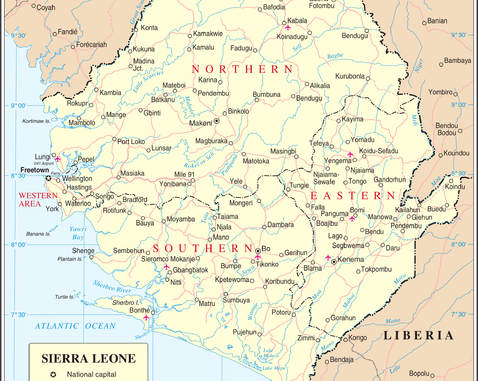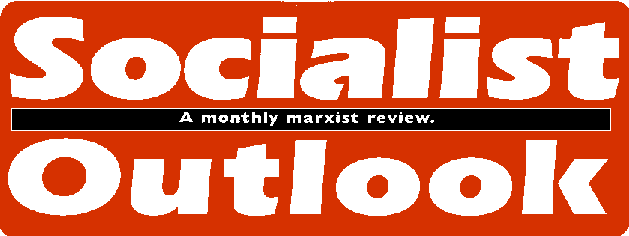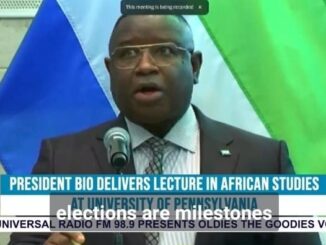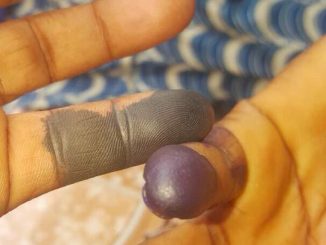
Bob Wood
Globalisation is fraying at the edges. For evidence, look no further than Africa. Look at the war between Ethiopia and Eritrea, look at the Congo, look at Angola or the Sudan. Or look at the unhappy country of Sierra Leone.
The British press, reporting on the recent renewal of conflict in the West African state has presented us with a simple counterposition. The constitutional, elected government of President Ahmed Tejan Kabbah is faced by a rebellion led by the pathologically criminal Foday Sankoh.
The only activity of the rebels is to rape and terrorise, and they specialise in random acts of mutilation and torture. The truth, as always, is more complicated, though scarcely more comforting.
Since it gained independence in 1961, Sierra Leone has been systematically pillaged by an alliance of western mining companies and corrupt local politicians.
The country is rich in mineral resources, particularly diamonds, now said to be funding the rebellion, but also iron ore, aluminium and titanium, the latter obtained through shallow mining of laterite, leaving vast areas in the south of the country environmentally sterile and useless for farming.
The profits from mining have all gone to line the pockets of mining company shareholders, merchants or local politicians, milking the state.
Corruption
The extent of this corruption can perhaps best be judged from the activities of Jamil Sahid Mohammed, the Afro-Lebanese crony of the late President, Siaka Stevens. Although he was not an elected politician, in addition to controlling both the diamond and fishing industries, Mohammed attended Cabinet meetings and influenced political appointments.
At the same time, the President’s secretary was busy selling civil service appointments, for example an aspiring district officer might have to pay several thousand pounds on initial appointment, and then regular monthly payments for the privilege of retaining the job. Little imagination is required to understand who ultimately paid the cost of these bribes.
Since independence in 1961, the politics of Sierra Leone have been largely influenced by conflict for spoils between the elites of three main groups – the Mende in the south of the country, the Temne in the north, and the Krio, descendents of freed slaves, in the Freetown peninsular. These ethnic conflicts have often subdued, but of course never entirely over-ridden class conflict.
After independence, the country was ruled successively by the Margai brothers from the Mende south, leaders of the SLPP (Sierra Leone People’s Party), with the APC (All People’s Congress) in opposition. Siaka Stevens, the leader of the APC took office in 1968, following disputed elections and a short-lived military intervention.
Stevens had been a trade union leader on the railways, and although he came from the north was not a Temne but from the smaller Limba tribe. Ruling first as Prime Minister, then as President of a one-party state, Stevens turned the moderate corruption of the Margai period into full-blown kleptocracy.
Successor
He was followed in 1985 by his chosen successor, Joseph Momoh, leader of the armed forces. Momoh was if anything even more corrupt than Stevens, and was eventually overthrown in 1992 by a group of junior officers under Valentine Strasser. These officers were concerned about the conduct of the war against the rebels which had by then begun.
The origins of the rebel organisation, the Revolutionary United Front (RUF), can be traced back to the late sixties and early seventies, a period of world-wide radicalisation. It came from the coalescence of student radicals and marginalised, disaffected and socially excluded elements in Freetown, of the kind that Marx and Engels dubbed the lumpenproletariat.
Radical influence
These circles were influenced by Guevara and Castro, books like Frantz Fanon’s The Wretched of the Earth, and to a limited extent by Lenin and Marx too. Serious disturbances took place on the campus of Fourah Bay College (the University of Sierra Leone in Freetown) in 1977, spreading to involve school students as well.
By the 1980s student groups were being influenced by Pan-Africanism, and by the ideas in Colonel Qaddafi’s Green Book. Talk of revolution was in the air, and the students adopted anti-imperialist slogans.
In 1985 forty-one students were expelled from Fourah Bay College for alleged Libyan links. These were undoubtedly trumped-up charges, for without evidence, the authorities said that the students had intended to allow their rooms to be used by Libyan mercenaries during the vacation! The president of the Student Union, Alie Kabba, was arrested and detained for several months.
Libya
But even if the detailed charge was spurious, the students were definitely interested in Libya, for thirty-five of them went there two years later, in 1987, for military training. With this group was Foday Sankoh, now the leader of the RUF.
Sankoh had first achieved notoriety when as Corporal Sankoh he had taken part in an abortive coup against the Stevens regime, for which he was jailed in the early seventies.
When the first small group of guerrillas entered Sierra Leone in March 1991, many of these students had dropped out, leaving a greater preponderance of lumpen elements in the leadership of the RUF. It is certainly the case that the ideology of the RUF has become more confused, and marginal to its activities as time has passed. But they still have a residual politics.
In their statement to the talks which resulted in the Lome peace agreement in July last year, the RUF said: “After the past eight years of our liberation struggle, which we commenced with reluctance, it is now crystal clear that our conflict is essentially socio-political and cannot be resolved by military means but through genuine negotiation.”
Programme
Their totally unrealistic political programme, promulgated at these talks, called for self-reliance and a gradual reduction in foreign assistance, but at the same time free education up to secondary level and free primary health care.
It is not surprising that they have sometimes been compared with Peru’s Shining Path guerrillas, or even the Khmer Rouge.
What does the lumpenproletariat represent socially? The term was coined by Marx to describe all those on the margins of society, those who have fallen out or dropped out.
In writing about the peasant wars in sixteenth century Germany, Engels said:
“The lumpenproletariat is generally speaking a phenomenon more or less developed in all phases of society to date … people without a definite occupation and a stable domicile … In wartime some of these tramps joined the armies, others begged their way across the countryside, and others eked out a meagre living in the towns …”
Later he wrote: “The lump lends his fist for a few talers to fight out the spats among the bourgeoisie, nobility and police.”
The Communist Manifesto was perhaps even less kind: “The lumpenproletariat, this passive putrefaction of the lowest strata of the old society, is here and there swept up into the movement of the proletarian revolution (but) in accordance with all its condition of life, it is more apt to sell itself to reactionary intrigues.”
And finally, in writing about the role of Louis Bonaparte in the Paris of 1848, Marx said that he was the “chief of the lumpenproletariat … who recognises in this scum, offal, refuse of all classes, the only class upon which he can base himself unconditionally.”
This is not to say that lumpen elements are only to be found in the RUF. Political thuggery, making use of the poor and dispossessed of Freetown, has a long and inglorious history in Sierra Leone, dating back to the sixties.
Some police methods, involving beating suspects rather than using more subtle forensic techniques, can be traced back to the colonial period. Human rights abuses, including mutilation, torture and summary execution have been practised by both sides in the civil war.
Pressure
The government has generally been less culpable than the rebels, but probably only because it is more beholden to international opinion.
The most recent testimony to the government’s behaviour is the way in which the recently captured and wounded Foday Sankoh was paraded naked through the streets of Freetown.
What of the future? The intervention of the UN, and now British forces, has been no more helpful in resolving the crisis in this poverty-stricken and war-torn country than the previous campaign by Nigerian-led West African forces. Whatever the origins of the civil war, it is clear that since 1997, its shape has changed.
The alliance formed then between parts of the Sierra Leone Army and the RUF has consolidated the hold of the rebels over the northern part of the country. The map showing the areas held by the rebels is almost entirely the same as the areas where the Temnes live.
Pipedream
By the same token, the areas controlled by the government are the Mende areas. Any prospect of completely defeating the rebels is a pipedream, although as long as the government can hold Freetown, with international military assistance, the rebels can be contained.
New political structures must be found – possibly some type of federal arrangement, with powers devolved to the regions. The Kabbah government was elected using a closed list system, similar to the European elections in this country, leaving the political elites in the parties to pick their representatives.
And one of the reasons why the most recent peace agreement broke down may well have been the failure to implement one of its clauses – the holding of local elections.
What remains certain is that none of the imperialist countries largely responsible for the current state of Sierra Leone can be trusted to find an ethical solution.
![]()





Leave a Reply